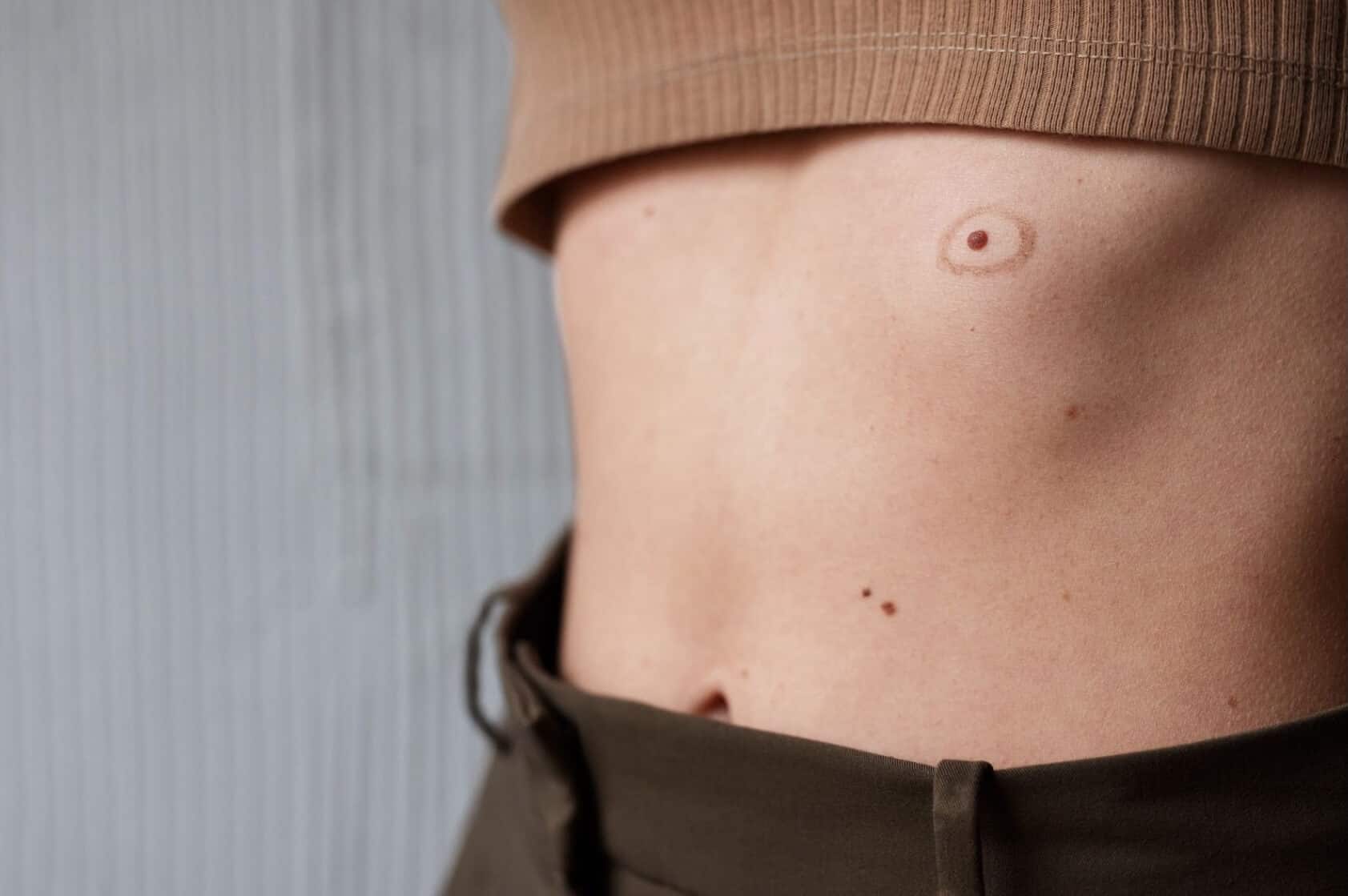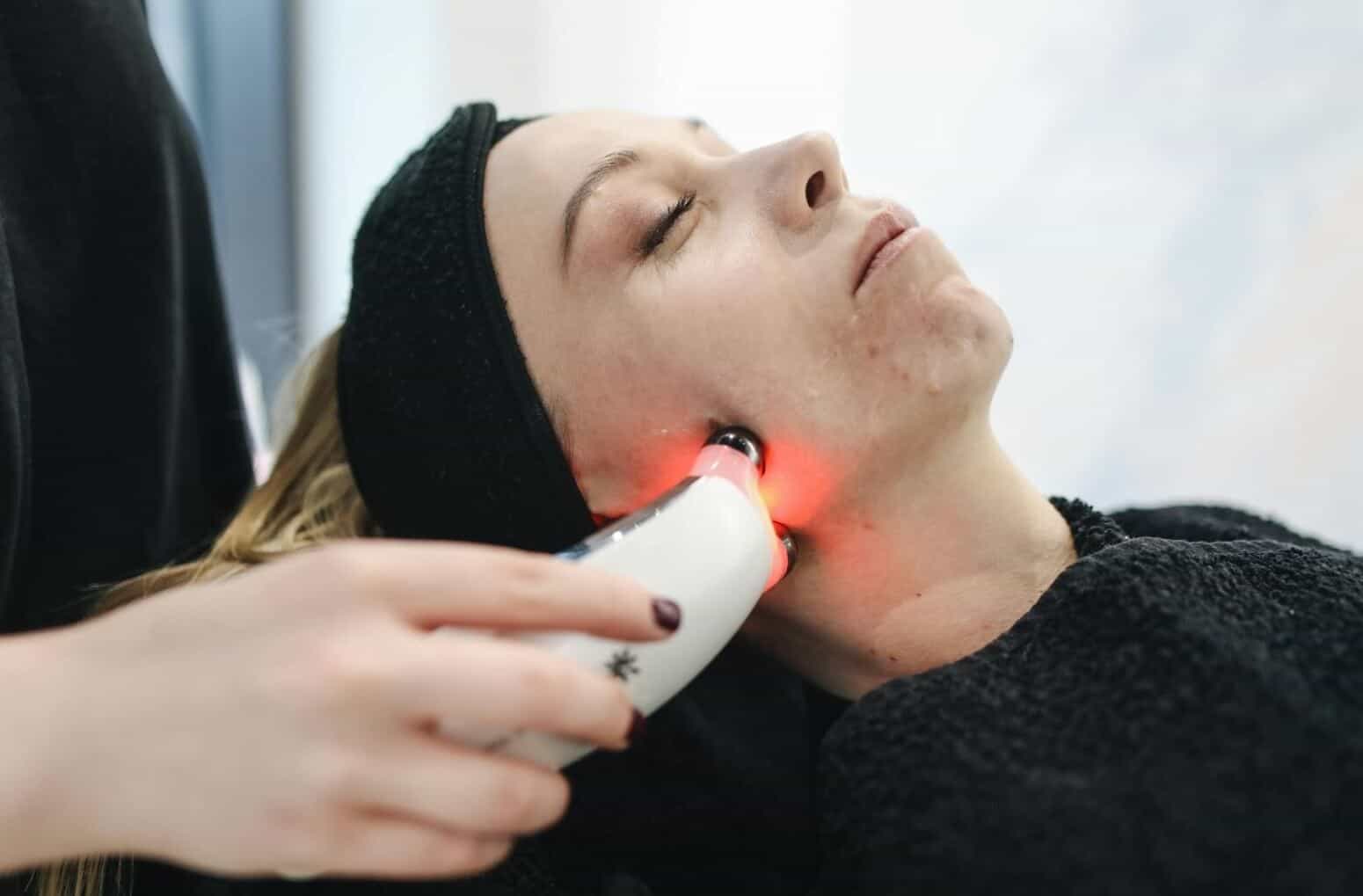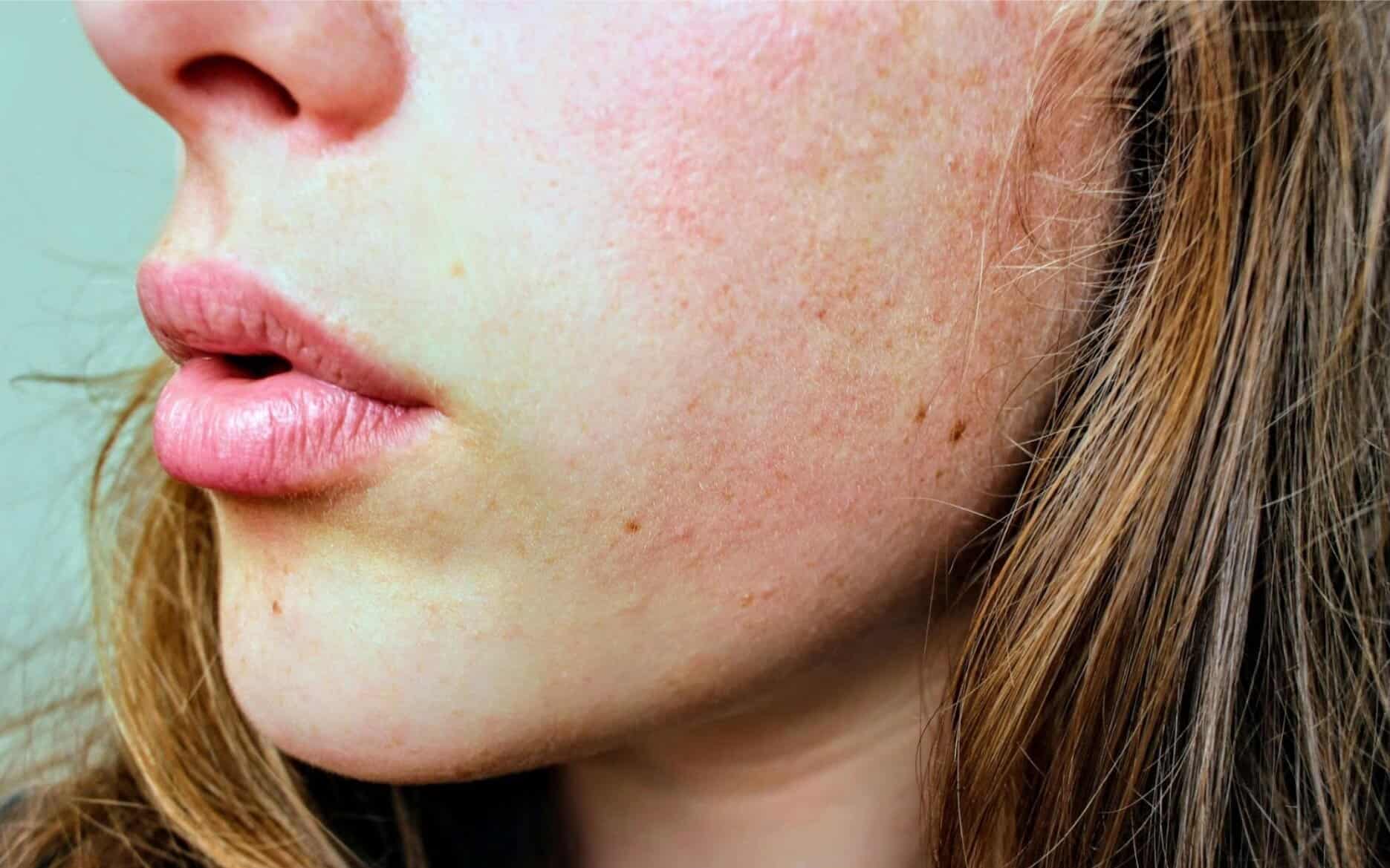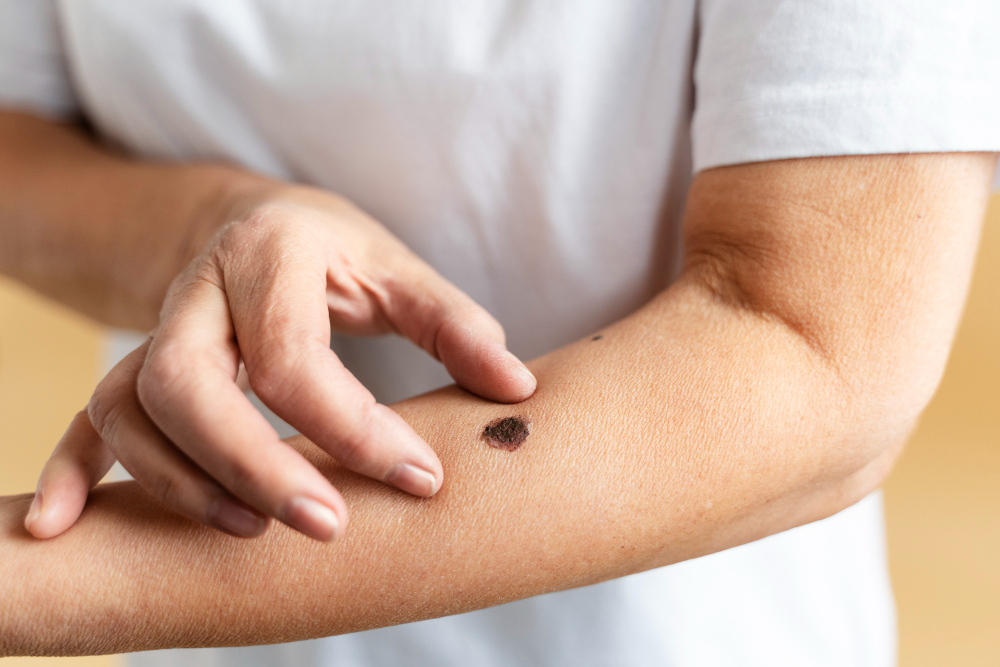Flat warts are small, smooth viral growths appearing in clusters on skin. Caused by HPV, they commonly affect face, hands, and legs. While usually harmless, various treatments can help eliminate these persistent bumps.
- Dr Sharon Crichlow
- Reading Time: 10 Mins
Spotting a bright red mole on your skin can be worrying. While most red moles are harmless cherry angiomas, some could be signs of skin cancer. Knowing the difference between these common skin growths and potentially dangerous melanoma could save your life. Let’s explore how to identify these skin lesions and when you should seek medical advice.
Key Takeaways
- Cherry angiomas are benign red moles that remain stable, while melanomas show irregular growth and changes.
- Use the ABCDE rule (Asymmetry, Border, Colour, Diameter, Evolution) to identify suspicious red skin lesions.
- See a dermatologist for any red moles that bleed unexpectedly, change appearance, or grow rapidly.
Table of Contents
What Causes a Red Mole on the Skin?
Red moles generally form when blood vessels cluster together near the skin’s surface. The most common type, cherry angiomas, occur when small blood vessels dilate and break, creating visible red spots on the skin.
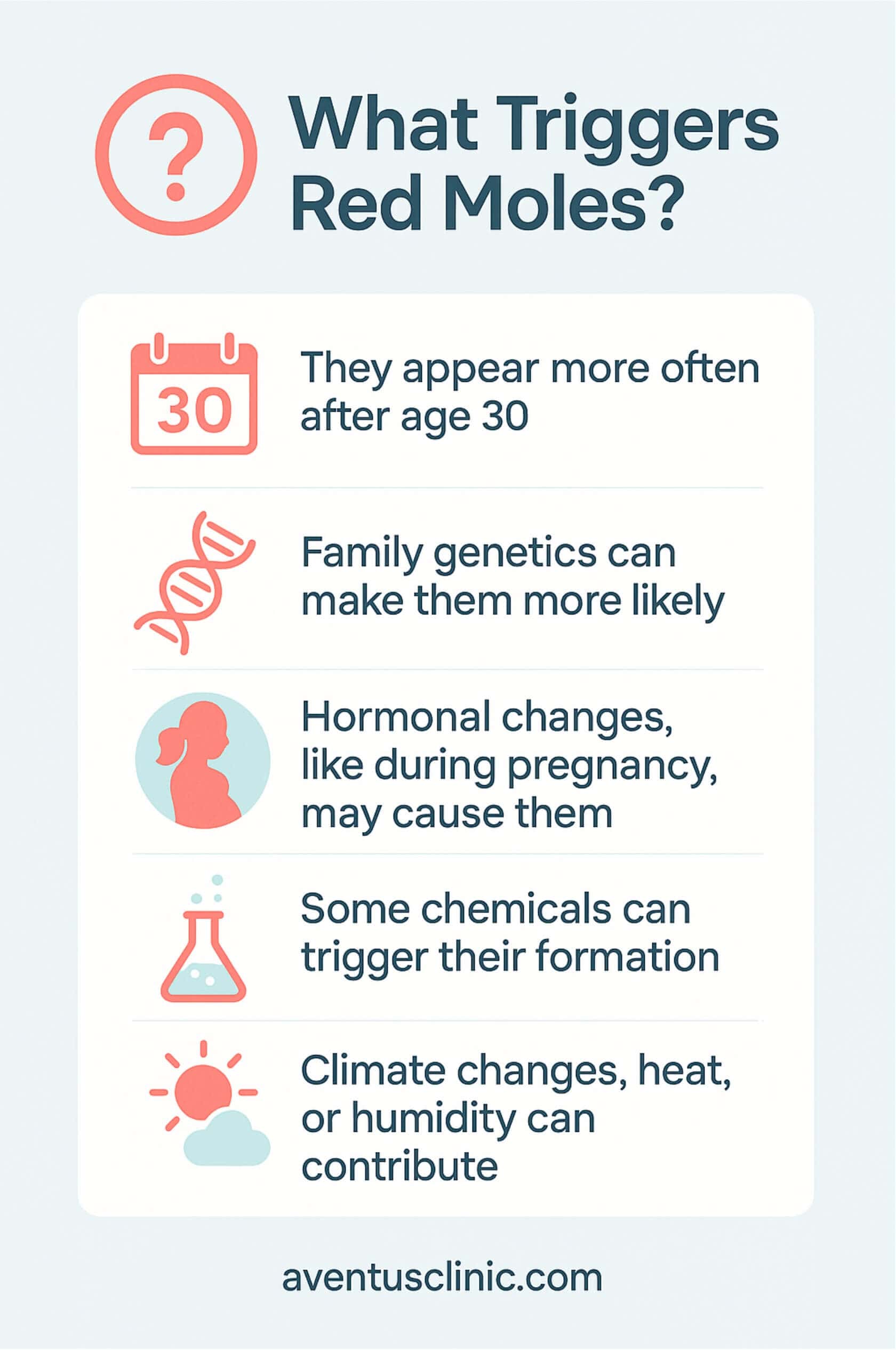
Not all red lesions are cherry angiomas, though. Some could be spider angiomas, pyogenic granulomas, or, in rare cases, amelanotic melanoma, a type of skin cancer lacking the typical brown or black pigmentation.
What Does a Cherry Angioma Look Like?
Cherry angiomas have distinctive characteristics that help identify them:
| Feature | Description |
|---|---|
| Colour | Bright red, ruby-red, or purple-red |
| Shape | Round or oval, dome-shaped |
| Size | Usually small (1–5mm in diameter) |
| Texture | Smooth, often slightly raised |
| Border | Well-defined, clear edges |
| Surface | May appear as a collection of tiny blood vessels |
Under a dermatoscope, cherry angiomas typically show multiple, well-demarcated red-purple “lagoons”, a pattern that helps distinguish them from malignant lesions, according to a 2021 study in Frontiers in Medicine.
These benign growths may bleed if scratched or irritated, but typically cause no discomfort or symptoms.
What Does Melanoma Look Like on the Skin?
Melanoma typically appears as an irregular, dark-coloured mole. However, amelanotic melanoma, a less common variant, can appear reddish, pink, or flesh-coloured, making it easily confused with cherry angiomas.
Warning signs of melanoma follow the ABCDE rule:
- Asymmetry: Uneven shape
- Border: Irregular, ragged, or blurred edges
- Colour: Varied shades within the same lesion
- Diameter: Larger than 6mm (though can be smaller)
- Evolving: Changes in size, shape, or colour
If you’re concerned about any moles on your skin, our comprehensive mole checking service provides thorough evaluations with same-day results in most cases.
Cherry Angioma vs. Melanoma: How to Spot the Difference
Distinguishing between these two conditions is crucial:
| Feature | Cherry Angioma | Melanoma |
|---|---|---|
| Colour Pattern | Uniform red/purple | Often varied (red areas may contain other colours) |
| Border | Well-defined, smooth | Irregular, notched, or blurred |
| Surface | Smooth, dome-shaped | May be uneven or ulcerated |
| Growth | Slow, minimal change | May grow or change rapidly |
| Vascular Pattern | Multiple "lagoons" under dermoscopy | Polymorphous/linear-irregular vessels |
| Feel | Usually painless | May itch, bleed, or feel tender |
| Age of Onset | More common after age 30 | Can appear at any age |
If you’re uncertain about a red lesion, it’s always best to consult a specialist dermatologist for professional evaluation and peace of mind.
Common Areas Where Red Moles Appear
Cherry angiomas can develop anywhere on the body, but certain locations are more common. A population imaging study published in Dermatology (2022) mapped their distribution, showing a clear preference for the trunk.
The chest and back are prime locations, followed by the arms and shoulders. They’re less common on the face, hands, and feet. This distribution pattern can help distinguish them from other skin conditions.
Location alone doesn’t determine whether a growth is concerning, but it provides helpful context. Cherry angiomas on the face or neck may cause more cosmetic concerns, while those under clothing might experience irritation.
Any new or changing growth deserves attention, regardless of location. The most important factor is how the growth behaves over time.
When Should You See a Dermatologist for a Red Mole?
While most red moles are harmless, certain warning signs should prompt medical evaluation.
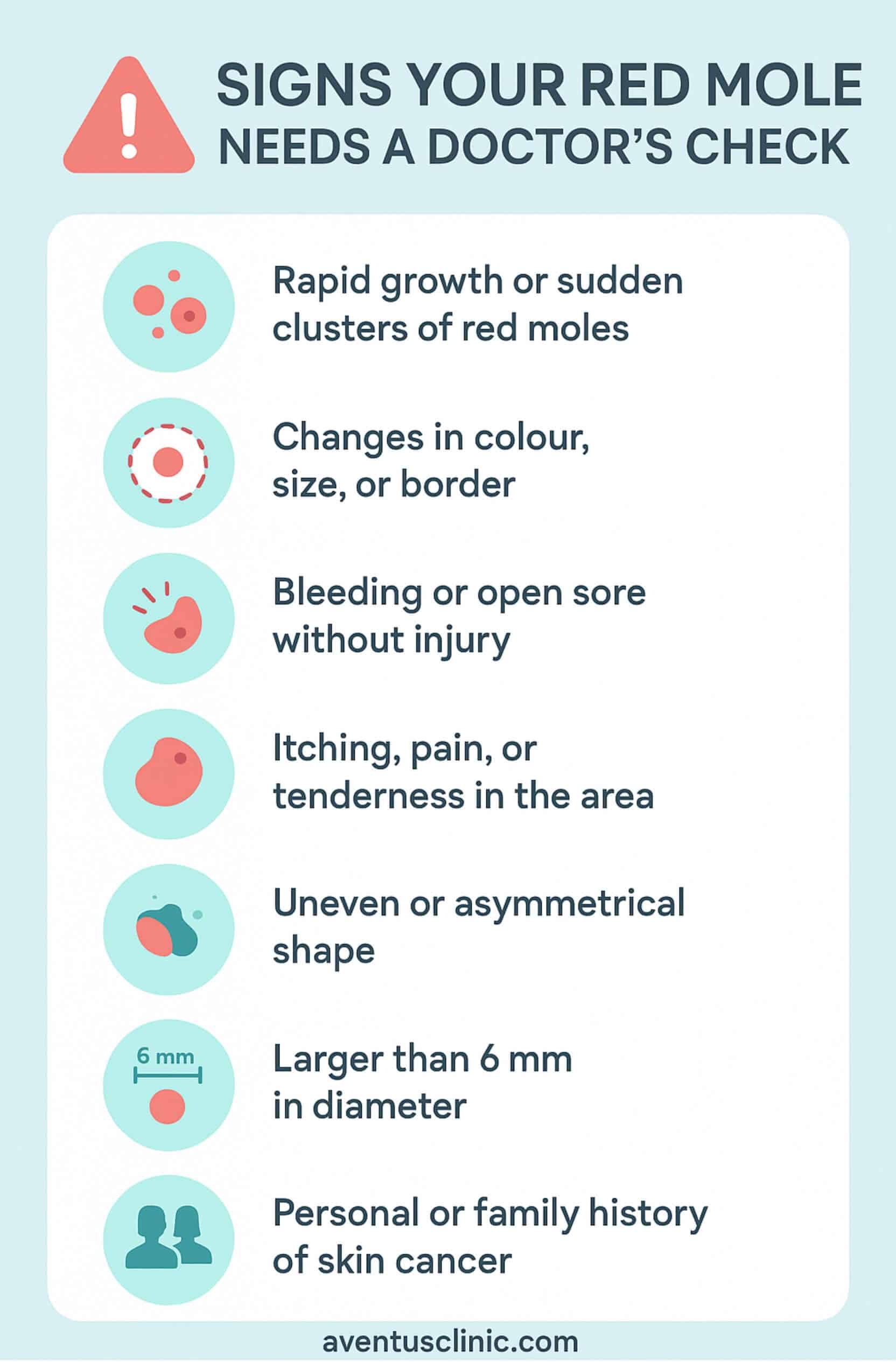
A study noted that eruptive cherry angiomas (sudden appearance of multiple lesions) showed an association with malignant melanoma, suggesting that patients with this presentation merit careful skin examination.
Trust your instincts. If something doesn’t seem right about a skin lesion, seeking professional evaluation is always the safer choice.
How Are Red Moles Diagnosed and Treated?
Proper diagnosis of red skin lesions relies on several advanced techniques.
The diagnostic process for red moles typically begins with a thorough visual examination. Your dermatologist will first assess the growth with the naked eye, then use a dermatoscope for more detailed viewing.
If there’s any uncertainty, a biopsy may be recommended. This involves removing all or part of the growth and examining it under a microscope.
For confirmed cherry angiomas, several treatment options exist:
| Treatment | How It Works | Recovery Time |
|---|---|---|
| Laser Removal | Uses targeted light energy to collapse blood vessels | Minimal downtime, slight redness for 1–2 days |
| Cryotherapy | Freezes the growth with liquid nitrogen | Blister forms and heals within 1–2 weeks |
| Electrocautery | Uses electrical current to heat and remove tissue | Small scab forms and falls off within 1–2 weeks |
Cherry angioma removal is typically performed for cosmetic reasons, while melanoma treatment aims to eliminate cancer and prevent spread.
Our clinic provides safe and effective mole removal in Hertfordshire for both cosmetic and medical concerns, with histological analysis of all removed tissue.
Conclusion
While most red moles are harmless cherry angiomas, knowing the warning signs of melanoma could save your life. Regular skin checks and prompt medical attention for suspicious lesions are essential steps in skin cancer prevention. If you’re concerned about a red mole, start with our free online skin assessment to get expert guidance on the next steps for your skin health.
FAQs
Can a red mole appear suddenly and still be harmless?
Yes. Cherry angiomas can develop quite suddenly and still be completely benign. However, the rapid appearance of multiple red moles or dramatic changes in existing ones should be evaluated by a dermatologist.
Are cherry angiomas linked to stress or hormones?
Hormonal changes, particularly during pregnancy, can trigger the development of cherry angiomas. While stress isn’t directly linked, some patients report new angiomas during high-stress periods, though scientific evidence for this connection is limited.
Can melanoma start as a red mole?
Yes. Amelanotic melanoma often appears as a red, pink, or skin-coloured lesion rather than the typical dark mole. Any red lesion that changes, grows, bleeds, or has irregular borders should be examined promptly.
Do cherry angiomas go away on their own?
Cherry angiomas don’t typically disappear once they’ve formed. They may grow slightly larger with time, but generally remain stable throughout life unless treated or removed.
Should I remove a red mole for cosmetic reasons?
Removing cherry angiomas for cosmetic reasons is safe and common. Professional removal offers better cosmetic results and allows for histological examination if there’s any uncertainty about the diagnosis.
 Free Online Assessment
Free Online Assessment WHATSAPP
WHATSAPP
